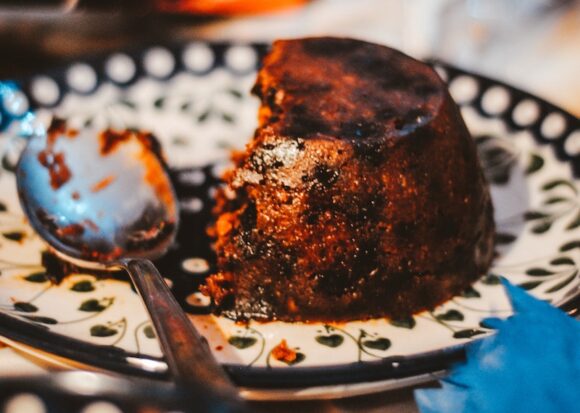Editor’s Note: We are delighted to re-publish this mouth-watering piece by our friend and former colleague at ‘Main Street News,’ Linda Ahnert of Old Lyme. She wrote it back in 2005 but has recently updated it for us.

“There’s a happy feeling nothing in the world can buy, when they pass around the coffee and the pumpkin pie” . . . and, of course, “Everybody knows a turkey and some mistletoe help to make the season bright.”
Have you ever thought how many food references there are in Christmas songs? It runs the gamut from figgy pudding to popcorn! And food plays a starring role in many Christmas stories and in our own memories.
I was about 10-years-old when I received “Little Women” as a Christmas present. It is the beloved book about the four March sisters growing up in New England. As the story opens, it is a Christmas during the Civil War and the March family is living in straightened circumstances. But when the girls hear of a needy family in the neighborhood, they gladly give up their Christmas breakfast to feed the hungry children. Even self-centered Amy sacrifices her favorite things—“the cream and the muffins.”
Jo March laments, “Christmas won’t be Christmas without any presents.” And for most of us, Christmas wouldn’t be the same if we didn’t have some particular food in the house during the season.

For instance, one of my early food memories of Christmas is tangerines and walnuts. My paternal grandparents came to this country from Germany. On Christmas Eve, everyone would gather at their home. I remember my grandfather playing the mandolin and singing “Stille Nacht” and other German carols. My grandmother decorated the buffet in the dining room with evergreen boughs. Interspersed in the greens were tangerines and all varieties of nuts in the shell. Before we left, my grandmother would stuff our mittens with the fruit and nuts.
Another family that I spent many hours with as a child were the Ingalls in the “Little House” books. How I loved reading about the adventures of Laura, Mary, Carrie, Ma, and Pa as they crossed the prairie. The author, Laura Ingalls Wilder, describes the delight of the children one Christmas morning. The girls have reached into their stockings to find shiny tin cups and each has a “long, long stick” of peppermint candy, striped red and white.
But their stockings weren’t empty yet. The girls pull out small packages and unwrap them to discover heart-shaped cakes. “Over their delicate brown tops was sprinkled white sugar. The sparkling grains lay like tiny drifts of snow.” It might be a simple Christmas on the frontier, but the girls can’t imagine being any happier.
Across the pond in Merrie Olde England, Charles Dickens included numerous descriptions of food in “A Christmas Carol.” You may not look forward to your weekly trips to the Big Y but, trust me, your mouth will water reading Dickens’ descriptions of the produce in the London grocery shops at Christmas.
And who could forget the account of the Cratchit Christmas dinner? (“There never was such a goose.”) To complement this “feathered phenomenon,” Mrs. Cratchit “made the gravy (ready beforehand in a little saucepan) hissing hot, Master Peter mashed the potatoes with incredible vigor, Miss Belinda sweetened up the apple sauce . . . ”

Bob Cratchit rolled up his threadbare sleeves and “compounded some hot mixture in a jug with gin and lemons, and stirred it round and round, and put it on the hob to simmer.” In 21st century parlance . . . I’ll have what they’re having.
Truman Capote’s “A Christmas Memory” is an autobiographical story set in rural Alabama in the 1930s. It opens on a November morning when the elderly cousin who is raising seven-year-old Buddy announces that “It’s fruitcake weather!” For Buddy this means the official start of the Christmas season. They begin the yearly ritual of gathering pecans in an old buggy and scrimping together their meager funds to buy the ingredients to bake 30 fruitcakes.
For days “eggbeaters whirl, spoons spin round in bowls of butter and sugar, vanilla sweetens the air, ginger spices it; melting, nose-tingling odors saturate the kitchen, suffuse the house, drift out to the world on puffs of chimney smoke.” When the work is done, the “cakes, dampened with whiskey, bask on windowsills and shelves.”
In our family, too, the holiday season always began on a November day. A week or two before Thanksgiving, we would receive a package of pecans from Louisiana. They were from the trees in my aunt’s yard, and she sent them each year in time to bake our holiday desserts. My mother was born and raised in Louisiana, and it wouldn’t have been Christmas in our house without cornbread and pecan pies.
And so, gentle readers, whether your Christmas traditions include roasting chestnuts on an open fire or whipping up a batch of wassail, may God bless us, everyone.
Editor’s Note: This is another offering from our friend and Linda Ahnert of Old Lyme.
And God bless you, Linda Ahnert, for writing this wonderful article which included several books I grew up loving as well.
This is so charming! Would you consider running this again, may be about Thanksgiving time, so families can look for the books and maybe even try the recipes? Reading it now adds to my sorrow that the season is behind us